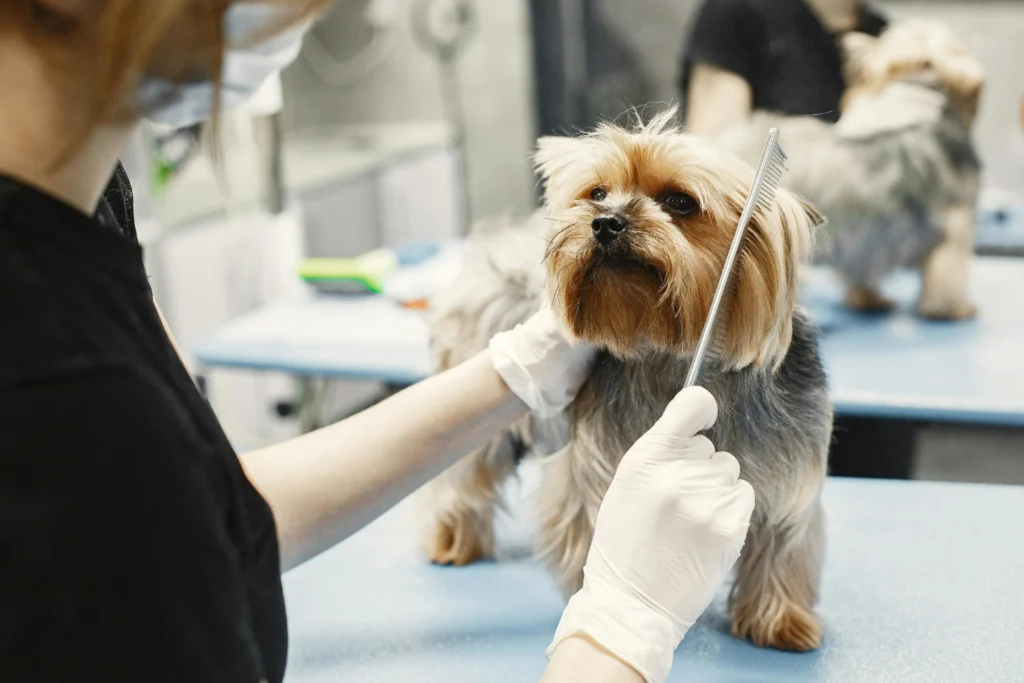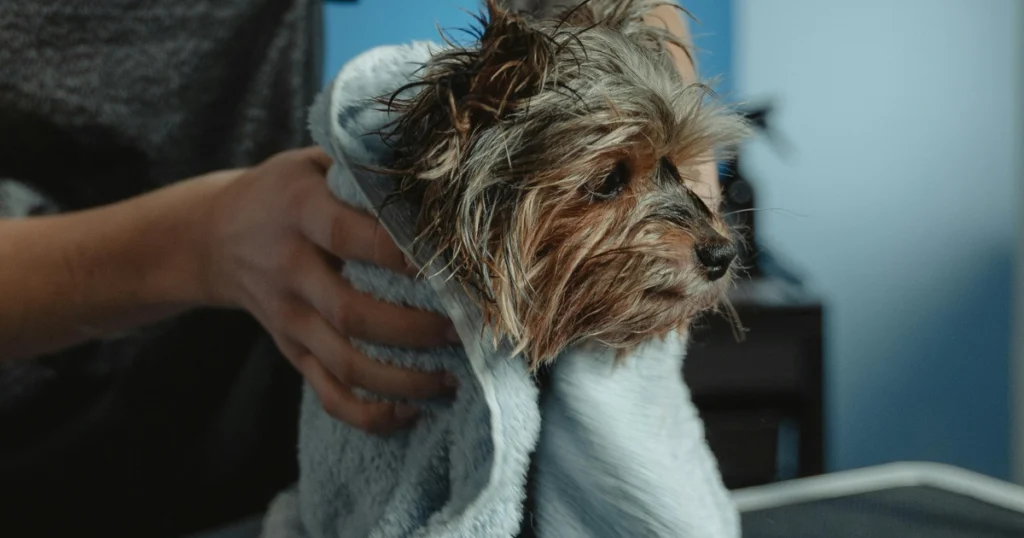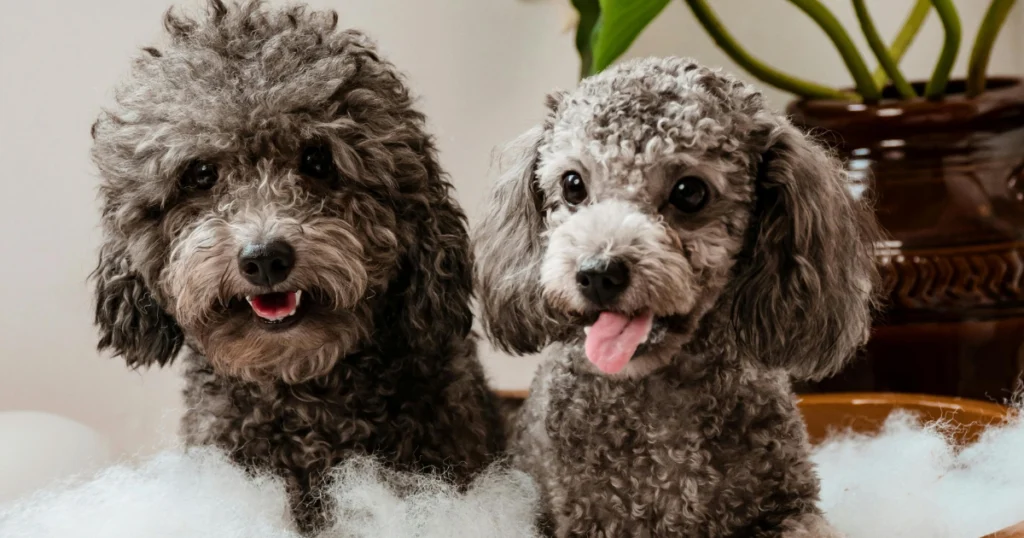DIY doggie styles grooming tips

DIY doggie styles grooming tips:Easy Tricks in 2025
Grooming your dog at home can make them look and feel great without costing a lot. With the right tools and techniques, you can style your dog’s fur at home. This guide will show you how to do it and become a pro at dog grooming.
Table of Contents
Getting your dog groomed at home is easier than you think. It doesn’t matter if your dog has short or long fur. Learning the basics of dog grooming can save you money and strengthen your bond with your pet.
Key Takeaways
- Learn professional-level dog grooming techniques at home
- Save money on expensive professional grooming services
- Improve your pet’s coat health through regular maintenance
- Develop a stronger connection with your dog during grooming sessions
- Understand the unique needs of different coat types
- Prevent common grooming mistakes that could harm your pet
Essential Grooming Tools and Supplies for Home Pet Care
Keeping your dog looking great starts with the right tools and supplies. You don’t need to spend a lot on professional grooming. With the right gear, you can groom your dog at home.
Quality grooming equipment saves time and money. It also keeps your dog comfortable and clean. Choose tools that fit your dog’s coat type and grooming needs.
Professional-Grade Brushes and Combs
Different coats need special brushes. Here are some must-haves:
- Slicker brushes for removing loose fur and preventing matting
- Undercoat rakes for thick-coated breeds
- Bristle brushes for short-haired dogs
- Pin brushes for long and silky coats
Quality Clippers and Scissors
Professional-grade clippers are key for coat maintenance. Look for:
- Cordless clippers with multiple blade sizes
- Quiet motors to reduce dog anxiety
- Sharp, durable blades for clean cuts
- Ergonomic designs for comfortable handling
Grooming Table Options
A stable grooming surface makes pet care easier. Consider adjustable tables with non-slip surfaces and restraint hooks for safety and convenience.
“The right tools transform grooming from a chore into a bonding experience with your dog.” – Professional Dog Groomer
Choose your grooming equipment wisely for a comfortable and effective home pet care routine.
Preparing Your Dog for the Grooming Session

Getting your dog ready for grooming starts with creating a calm space. It’s important to make grooming a comfortable and stress-free experience. Knowing your dog’s personality helps a lot.
Start by letting your dog get used to grooming tools. Let them sniff and explore brushes, clippers, and more before you begin. This helps lower their anxiety and builds trust.
- Create a quiet, familiar space for grooming
- Use positive reinforcement with treats
- Start with short grooming sessions
- Remain patient and calm
Desensitization is key in pet grooming, as many tips suggest. Practice touching your dog’s paws, ears, and body often. Short, regular touches can greatly help in making your dog calm during grooming.
“Patience and consistency are your greatest tools in dog grooming preparation.” – Professional Dog Groomers Association
| Grooming Preparation Step | Purpose | Recommended Frequency |
|---|---|---|
| Touch Training | Reduce sensitivity to handling | Daily, 5-10 minutes |
| Tool Introduction | Familiarize dog with grooming tools | Weekly |
| Short Practice Sessions | Build grooming tolerance | 2-3 times per week |
Every dog is different. Some may need more time and patience. Listen to your dog’s cues and adjust your approach. The aim is to turn grooming into a special bonding time.
Basic Bathing Techniques and Best Practices
Dog bathing can be tough for pet owners. But, with the right techniques, it can be easy and fun for both you and your dog. Knowing how to wash dogs helps keep them clean and their coats healthy.
Choosing the Right Pet Shampoo
Choosing the right pet shampoo is key for your dog’s skin and coat. Different dogs need different shampoos:
- Short-haired dogs: Mild, gentle shampoos
- Long-haired breeds: Moisturizing formulas
- Sensitive skin: Hypoallergenic options
Proper Washing and Rinsing Methods
Good dog bathing is more than just shampoo. Here are the key steps:
- Wet the coat well with lukewarm water
- Apply pet shampoo gently in circular motions
- Rinse well to avoid skin irritation
Drying Techniques for Different Coat Types
Drying right is crucial for skin health and coat care. Here’s a guide for drying dog coats:
| Coat Type | Recommended Drying Method |
|---|---|
| Short, smooth coats | Towel dry, air dry |
| Long, thick coats | Low-heat blow dryer, careful brushing |
| Curly or woolly coats | Gentle blow-drying, frequent brushing |
Pro tip: Always use a towel or pet-specific blow dryer to avoid skin burns and discomfort.
Popular Doggie Styles and How to Achieve Them
Dog hairstyles are a fun way to show off your pet’s personality and keep them looking great. You can choose from classic styles or grooming techniques specific to certain breeds. There are many popular dog cuts to try out.
- Classic Puppy Cut: Perfect for most breeds, this versatile style keeps your dog cool and neat
- Teddy Bear Cut: Adorable rounded trim that works great for fluffy breeds
- Lion Cut: Dramatic style that transforms your dog into a mini-lion
- Sporting Cut: Practical option for active dogs with thick coats
When picking dog hairstyles, think about your pet’s breed, coat type, and how active they are. Professional groomers say it’s important to know your dog’s coat before trying out new cuts.
“The right grooming style can make your dog look amazing and feel comfortable!” – Professional Pet Groomer
| Breed | Recommended Cut | Maintenance Level |
|---|---|---|
| Poodle | Continental Clip | High |
| Shih Tzu | Puppy Cut | Medium |
| Golden Retriever | Sporting Trim | Low |
To groom your dog at home, get good tools and take your time. It takes practice to get good at popular dog cuts and breed-specific grooming.
Pro tip: Always consult with a professional groomer before attempting complex haircuts to ensure your dog’s comfort and safety.
Mastering Brush-Out Techniques for Different Coat Types

Dog coat care needs special brushing methods for each fur type. Knowing how to groom your dog right can stop painful matting and keep their skin healthy. Every breed and fur texture needs its own grooming way.
Professional groomers say detangling dog fur is more than just brushing. It’s about picking the right tools and using soft, smart methods to care for your dog’s skin and fur.
Long-Coat Brushing Methods
Dogs with long, fluffy coats need extra care. Here are key brushing tips:
- Use a slicker brush with gentle, slow strokes
- Start at the skin and work outward to remove loose undercoat
- Brush in the direction of hair growth
- Pay extra attention to areas prone to tangling, like behind ears and under legs
Short-Coat Maintenance Tips
Short-coated dogs might look easier to groom, but they still need regular care. Here are some important tips:
- Use a rubber curry brush to remove dead hair
- Brush weekly to distribute natural skin oils
- Check for skin irritations during grooming sessions
Dealing with Matted Fur
Matted fur can be very painful and might lead to skin infections. When you find tough mats:
- Never pull or yank at tangled fur
- Use a detangling spray designed for dogs
- Work slowly with a wide-toothed comb
- Consider professional help for severe matting
“Patience and gentle technique are the keys to successful dog grooming.” – Professional Pet Groomer
Regular brushing not only keeps your dog looking good but also strengthens your bond through caring interaction.
Common Grooming Mistakes to Avoid
Dog grooming can be tough for pet owners. Knowing common dog grooming errors helps avoid stress for you and your dog. Spotting pet care mistakes early saves time, money, and keeps your dog comfortable during grooming.
- Using the wrong grooming tools for your dog’s coat type
- Cutting nails too short and causing bleeding
- Bathing your dog too frequently
- Skipping regular brushing
- Neglecting ear and dental hygiene
Professional groomers say to avoid these big grooming mistakes. Wrong techniques can cause skin problems, coat damage, and even injuries.
| Mistake | Potential Consequence | Prevention Strategy |
|---|---|---|
| Incorrect Brush Selection | Coat damage | Use breed-specific brushes |
| Rough Handling | Dog anxiety | Use gentle movements |
| Irregular Grooming | Matted fur | Establish consistent routine |
“Patience and proper technique are key to successful home dog grooming.” – Professional Dog Groomer Association
Learning to spot and steer clear of common grooming errors is crucial. It keeps your dog healthy and looking good. Plus, it strengthens your bond through positive grooming experiences.
Maintaining Your Dog’s Grooming Between Sessions
Regular grooming is key to your dog’s health and happiness. A good grooming routine stops health problems and keeps your dog looking great. This part will show you how to groom your dog at home between visits to the groomer.
Daily Brushing Routines
Brushing your dog every day is very important. The type of coat your dog has will tell you how often to brush:
- Short-haired dogs: Brush 1-2 times weekly
- Medium-haired dogs: Brush 3-4 times weekly
- Long-haired dogs: Daily brushing recommended
Nail Care and Paw Maintenance
Trimming your dog’s nails is a must. It keeps them comfortable and helps them walk better.
| Dog Size | Nail Trimming Frequency | Recommended Tools |
|---|---|---|
| Small Breeds | Every 3-4 weeks | Scissor-style clippers |
| Medium Breeds | Every 4-6 weeks | Guillotine-style clippers |
| Large Breeds | Every 6-8 weeks | Professional-grade grinder |
Ear Cleaning and Hygiene
Cleaning your dog’s ears keeps them healthy. Use a special ear cleaner and soft cotton balls. Just wipe the outer ear, don’t go too deep.
“A clean ear is a healthy ear” – Veterinary Professionals
Home grooming helps a lot between professional sessions. It keeps your dog in top shape. Always talk to your vet for advice that fits your dog’s needs.
Conclusion
DIY dog grooming is a great way to bond with your dog and keep them healthy. It’s more than just saving money. You’ll learn how to meet your dog’s specific coat and skin needs.
Learning DIY dog grooming lets you give your dog care that pros might not. You can spot health problems early, like skin issues or changes in their coat. This keeps your dog happy, clean, and healthy between vet visits.
Being patient and practicing is important for at-home pet care. Begin with easy steps, use good tools, and get more confident over time. Each grooming session is a chance to show your dog love and care, making it a positive experience for both of you.
With effort and the right approach, grooming can become a special moment for you and your dog. Your dedication to learning and improving will make your pet happier, healthier, and more confident.
FAQ
How often should I groom my dog at home?
Grooming frequency varies by breed, coat type, and activity level. Short-haired dogs need brushing 1-2 times a week. Long-haired breeds may need daily brushing to avoid matting.
What are the essential grooming tools I need for home pet care?
You’ll need slicker brushes, metal combs, dog scissors, clippers, nail trimmers, and dog shampoo. The right tools depend on your dog’s coat and grooming needs.
How can I keep my dog calm during grooming sessions?
Use treats and praise for positive reinforcement. Introduce grooming tools slowly. Start with short sessions in a calm environment. Regularly practice handling your dog’s paws and ears to reduce anxiety.
What’s the best way to bathe my dog at home?
Use lukewarm water and dog-specific shampoo. Wet your dog’s coat well before applying shampoo. Massage gently, rinse thoroughly, and dry with a towel or cool setting blow dryer.
How do I prevent matting in my dog’s coat?
Brush daily or weekly, especially for long-haired breeds. Choose the right brush for your dog’s coat. Work through tangles gently and focus on areas prone to matting.
Can I trim my dog’s nails at home?
Yes, but be careful. Use dog-specific clippers and avoid cutting too close to the quick. Have styptic powder ready for bleeding. If unsure, seek a professional groomer or veterinarian.
How do I choose the right grooming products for my dog?
Consider your dog’s coat type, skin sensitivity, and any skin conditions. Consult your vet, read labels, and choose hypoallergenic, breed-specific products.
What are common grooming mistakes to avoid?
Don’t use human hair products, cut nails too short, or bathe too often. Use the wrong brushing techniques and neglect ear and dental care. Always use dog-specific grooming tools and products.
How can I make grooming a positive experience for my dog?
Start early, use treats and praise, and keep sessions short and fun. Be patient and gradually introduce new tools and techniques. Create a consistent routine and always end on a positive note.
What should I do if my dog has sensitive skin?
Use hypoallergenic, fragrance-free products and perform a patch test. Consult your vet about specific skin care needs. Consider oatmeal-based or medicated shampoos for sensitive skin.
